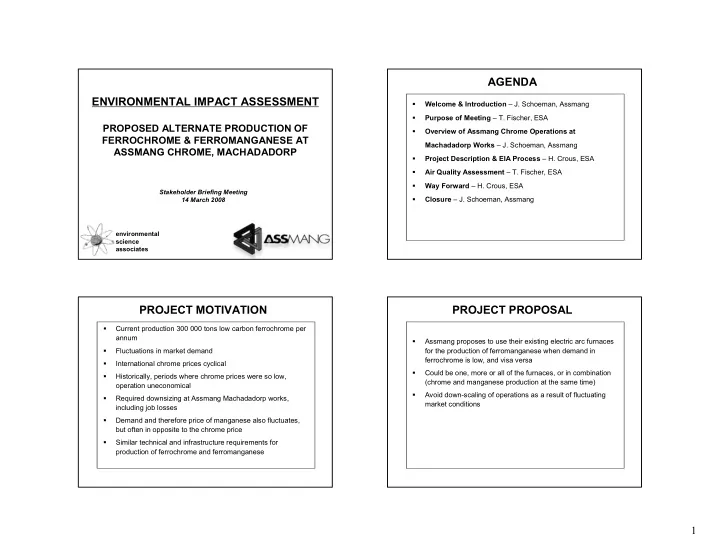

AGENDA ENVIRONMENTAL�IMPACT�ASSESSMENT � Welcome�&�Introduction – J.�Schoeman,�Assmang � Purpose�of�Meeting� – T.�Fischer,�ESA PROPOSED�ALTERNATE�PRODUCTION�OF� � Overview�of�Assmang�Chrome�Operations�at� FERROCHROME�&�FERROMANGANESE�AT� Machadadorp Works – J.�Schoeman,�Assmang ASSMANG�CHROME,�MACHADADORP � Project�Description�&�EIA�Process – H.�Crous,�ESA � Air�Quality�Assessment – T.�Fischer,�ESA � Way�Forward – H.�Crous,�ESA ���������������������������� � Closure� – J.�Schoeman,�Assmang ������������� environmental science associates PROJECT�MOTIVATION PROJECT�PROPOSAL � Current�production�300�000�tons�low�carbon�ferrochrome�per� annum � Assmang�proposes�to�use�their�existing�electric�arc�furnaces� � Fluctuations�in�market�demand for�the�production�of�ferromanganese�when�demand�in� ferrochrome�is�low,�and�visa�versa � International�chrome�prices�cyclical � Could�be�one,�more�or�all�of�the�furnaces,�or�in�combination� � Historically,�periods�where�chrome�prices�were�so�low,� (chrome�and�manganese�production�at�the�same�time) operation�uneconomical Avoid�down/scaling�of�operations�as�a�result�of�fluctuating� � � Required�downsizing�at�Assmang�Machadadorp works,� market�conditions including�job�losses � Demand�and�therefore�price�of�manganese�also�fluctuates,� but�often�in�opposite�to�the�chrome�price � Similar�technical�and�infrastructure�requirements�for� production�of�ferrochrome�and�ferromanganese �
LOCALITY PROJECT�DESCRIPTION� (1) � Similar�technical�requirements�for�production�of�manganese � Use�of�same�infrastructure�and�similar�management: � Transport � Raw�materials�– reductants,�fluxes,�coal� � Raw�material�storage�areas � Handling � Furnaces � Air�pollution�control�equipment � Energy � Labour � Management�&�Monitoring PROJECT�DESCRIPTION� (2) ENVIRONMENTAL�IMPACT�ASSESSMENT � Systematic�process�to�identify�potential�positive�and�negative� � Some�differences�that�would�require�modification�or� impacts� on� the� environment� (biophysical,� socio/economic,� infrastructure: cultural)�associated�with�proposed�activity. � ������������������������������������������������ (not� � Examine� alternatives� /� management� measures� to� minimise part�of�this�EIA�– being�done�seperately as�part�of�slag� negative�and�optimise positive�consequences. disposal�site�expansion�EIA) � Prevent�substantial�detrimental�impact�to�the�environment � Briquetting�plant�for�processing�bag�filter�dust�/ recycled� back�into�furnaces � Improve�the�environmental�design�of�the�proposal � Update�OHS�and�environmental�management�and� � Ensure�that�resources�are�used�efficiently monitoring�procedures � Identify�appropriate�management�measures�for�mitigation�and� � Increase�in�volume�of�raw�materials�and�energy�use,� the�monitoring�thereof emission�concentration�and�slag�volumes�not�expected� (rather�decrease) �
AIMS�&�ADVANTAGES�OF�EIA AIMS�&�ADVANTAGES�OF�EIA � To�authorities: � To�interested�and�affected�parties: � Informed�decision�making; � An�opportunity�to�voice�comments�and�concerns; � Improvement/protection�of�environmental�quality; � Protecting�environmental�rights; � Manage�sustainable�utilisation of�resources; � Utilisation of�local�and�indigenous�knowledge; � Understanding� demands� on� bulk� services,� waste� � Increased�knowledge�and�environmental�awareness. management�services,�urban/natural�forms,�etc. AIMS�&�ADVANTAGES�OF�EIA EIA�REQUIREMENTS � Government�Notice�R.385,�promulgated�in�terms�of�Section�24(5)�of� the�National�Environmental�Management�Act�(Act�107�of�1998)�– � To�the�developer: NEMA�EIA�Regulations � Compliance�with�environmental�standards�and�legislation; � Activities�listed�in�GN�R.386�and�R.387�requires�authorisation prior� to�commencement�– process�to�be�followed�described�in�GN�R.385: � Design�improvements�&�better�resource�utilisation; � Basic�Assessment�(R.386�Activities) � Improved�environmental�risk�management; � Scoping�and�EIA�(R.387�Activities) � Co/operation�from�local�communities�and�affect�parties; � Processes�mainly�different�in�terms�of: � Improved�corporate�social�responsibility. � Complexity�of�proposed�project; � Potential�significance�of�impacts; � Level�of�information�required; � Process�to�be�followed�&�timeframes.� �
‘LISTED�ACTIVITIES’ � In�terms�of�R.387,�the�construction�of�facilities�or�infrastructure,� including�associated�structures�or�infrastructure,�for: � �������������������������������������������������������������� ������������������������������������������������������������ �������������������������������������������������������������������� �������������� !�"#$����� � ������������������������������������������������������������������� �����%�������������� !�"#� � No�new�furnace�infrastructure�directly�related�to�ferromanganese production,�but�amendment�of�existing�Registration�Certificates�/� new�Air�Emission�Licenses�required�(NEM:�Air�Quality�Act,�2004). � New�briquetting�plant�for�recycling�of�bag�filter�dust. � New�manganese�slag�disposal�area�subject�of�separate�EIA. Application : Submit�application�to�CA Amend Accept Reject Public�Participation�Phase�1: Scoping� &�Plan�Of�Study for�EIA� (POSEIA ) Amend Submission : Submit�Scoping� &�POSEIA�to�CA Public�Participation�Phase�2: Environmental� Impact�Assessment Submission : Amend Submit�EIR�to�CA Reject Refuse Authorise �
ENVIRONMENTAL�ASPECTS ENVIRONMENTAL�ASPECTS � Handling� &� storage� of� manganese� ore,� product� and� slag� – � Furnace� operation� and� air� pollution� abatement� – emission� dust,�surface�water,�ground�water,�OHS level,�capacity�and�ambient�air�quality � Furnace� operation� and� air� pollution� abatement� – emission� � Handling� &� storage� of� manganese� ore,� product� and� slag� – level,�capacity dust,�surface�water,�ground�water,�OHS � Construction�of�briquetting�plant�– noise,�dust,�surface�water,� � Construction�of�briquetting�plant�– noise,�dust,�surface�water,� soil�(temporary) soil�(temporary) � Transition� from� chrome� to� manganese� – clean/up� of� � Transition� from� chrome� to� manganese� – clean/up� of� equipment,�handling,�disposal equipment,�handling,�disposal � Briquetting�plant�– dust,�storage�&�handling,�water � Briquetting�plant�– dust,�storage�&�handling,�water � Waste�handling�treatment�and�re/use�and�disposal Summary�of�Key�Issues Air�Quality�Assessment � Key�issues�addressed � Air Topographical � Particulate�emissions�(Cr�Mn) Data � Gaseous�emissions�(NOx) Meteorological Emissions Data Inventory � Water� � Geotechnical�and�groundwater�baseline � Capture�and�re/use�of�contaminated�water Dispersion�Model � Waste Air�Quality�Model � Treatment � Disposal Background�Air�Quality �
Recommend
More recommend